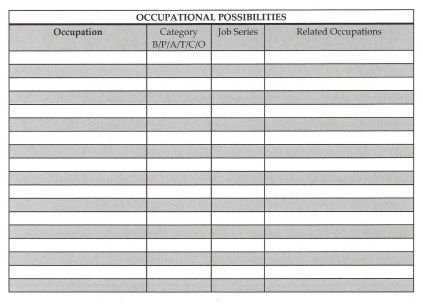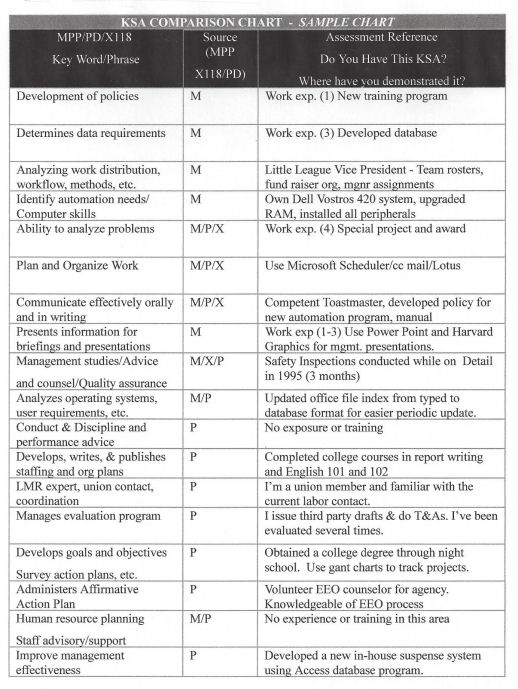Federal Employee's Career Development Center
Exploring Job Opportunities
Once an assessment is completed you will be able to match your Knowledge, Skills, Abilities and personality traits to specific job series. It won’t be as difficult as you may think. The federal government divides its General Schedule (GS) jobs, Occupational Series 0001 through 2210 into five broad categories.
Job Opportunities Menu
- Occupational Categories
- General Schedule
- Professional
- Administrative
- Technical
- Clerical
- Other
- Occupational Families (GS-0000 to GS-2200)
- Wage Grade
- 36 Occupational Families (WG-2500 to WG-9000)
- General Schedule
- Match Desired Careers to Occupational Categories
- Qualifying For Federal Jobs
- Qualification Standards
- Job Listings by Occupaton
- Merit Promotion Program (MPP) Announcements
- Identifying Relevant KSAs
- Other Resources
Occupational Categories (GS)
(P) Professional – White collar occupations that require knowledge in a field of science or learning characteristically acquired through education or training equivalent to a bachelor’s or higher degree with major study in or pertinent to the specialized field, as distinguished from general education. The work of a professional occupation requires the exercise of discretion, judgment, and personal responsibility for the application of an organized body of knowledge that is constantly studied to make new discoveries and interpretations, and to improve the data, materials, and methods.
(A) Administrative – White color occupations that involve the exercise of analytical ability, judgment, discretion, and personal responsibility, and the application of a substantial body of knowledge of principles, concepts, and practices applicable to one or more fields of administration or management. While these positions do not require specialized educational majors, they do involve the type of skills (analytical, research, writing, judgment) typically gained through a college level general education, or through progressively responsible experience.
(T) Technical – White collar occupations that involve work typically associated with and supportive of a professional or administrative field, that is nonroutine in nature; that involves extensive practical knowledge, gained through on-job experience and/or specific training less than that represented by college graduation. Work in these occupations may involve substantial elements of the work of the professional or administrative field, but requires less than full competence in the field involved. Occupational series in this category typically follow a one-grade interval pattern.
(C) Clerical – White collar occupations that involve structured work in support of office, business, or fiscal operations; performed in accordance with established policies, or techniques; and requiring training, experience, or working knowledge related to the tasks to be performed.
(O) Other white collar – White collar occupations that cannot be related to the above professional administrative, technical or clerical categories
Review the descriptions for the Occupational Families to seek out other options.
Blue collar occupations, Occupational Series 2501 through 9999, except 3506 and 9101 through 9199 are comprised of the trades, crafts, and manual labor (unskilled, semiskilled, and skilled), including foreman and supervisory positions entailing trade, craft, or laboring experience and knowledge as the paramount requirement.
Match Desired Careers to Occupational Categories
During the Assessment you were asked to list five career possibilities. List those original five selections on the Occupational/Job Possibilities form. Identify which category your five choices fall into, either blue collar or anyone of the five white collar categories.

Download the Occupational/Job Possibilities Form (Word Doc)
After reviewing the available occupations identify the related Occupational Group or Family for that occupation. For example, if you selected “Computer Clerk and Assistant Series (GS-335)” you would find this under the GS-300 General Administrative, Clerical, and Office Services Group. Note this group in column three of the chart next to your selection. In column four identify related series within that groups. In this example the obvious related occupations are (GS-334) Computer Specialist and (GS-332) Computer Operator. Information Technology (IT) jobs are featured in the GS-2200 family.
Gather information about the agency’s needs such as reorganizations, program changes, projected vacancies, and the competencies required for these positions. Agencies and Departments publish comprehensive planning documents that outline their long term organizational outlook. Look for publications such as Workforce 2015, and other documents issued by your Department or Agency. This may reveal other fast tracked occupations that you might like to explore. Think about your particular situation and add several additional selections to the list.
Two good examples of this type of analysis reveals the tremendous overall growth in the automation and environmental/safety fields with many agencies. The Information Technologist Series, GS-2210, is in the forefront of the automation changes as each organizational element is required to maintain hardware, upgrade software, and manage Local Area Networks (LANs), and Wide Area Networks (WANs). Now when e-mail fails, a computer breaks down, or the LAN server locks up the office needs someone there to reconfigure software and get the operation back on-line. The same holds true in the environmental arena. Environmental Health Technicians (GS-698) and Environmental Engineers (GS-819) are in demand due to the changes in the laws that hold federal managers and agencies accountable for OSHA and EPA violations. When you talk with your supervisor ask him/her for their perspective on upcoming organizational and workforce changes.
Add several additional selections to this list. You have been exposed to many occupations/job series since entering government service, some of which you might like to explore. List several occupations that you have some exposure to and that you find interesting and worth exploring.
You should now have at least 10 to 12 occupations targeted to explore. The chart will guide you to a number of conclusions. If most of your choices are in one category you can identify a number of Groups or Families that utilize similar skills. For example if you are currently a GS-341 Administrative Officer the primary classification is (A) Administrative.
“Good things come to those who wait,
as long as they work like hell while they wait.”
Many federal workers don’t look beyond their Occupational Group which in this case is the GS-300 General Administrative, Clerical, and Office Services Group. However, by reviewing the occupational lists and specific qualification standards you will find other jobs are categorized (A) Administrative in a number of groups. You will find similar type jobs such as GS-669 Medical Records Administration or GS-685 Public Health Program Specialist. Both jobs require an administrative background.
After identifying targeted positions the next step is to evaluate the training and courses that you need to attain the qualifications needed. Develop a training analysis with course recommendations and review the sample charts that we prepared to help you and your supervisor identify training needs.
Qualifying For Federal Jobs
Now that you have a laundry list of jobs to explore it’s time to evaluate those occupations to see if they are a good match. MPP Job Vacancy Announcements, Qualification Standards, and Position Descriptions (PD) are readily available from your Human Resources office. All three provide valuable information that you can use to narrow your job search to one or two top choices. Obtain PDs from the advertising agency for specific job announcements. You can also find job postings and position qualification standards online:
- Qualification Standards
- Federal Job Listings
Identifying Relevant KSAs
After reviewing the job announcements and qualification standard of interest and the sample KSA Comparison Chart review your personal documents that you obtained from your search. Highlight or underline key words and phrases that represent KSAs then transfer them to the KSA Comparison Charts similar to the way it was done on the sample. Use the downloadable comparison chart form to list your key words and phrases and note the references from your assessments section. Expand on your references if necessary. Use black sheets of paper and key the continuation data to your chart assessment block. The more data you pull out here the easier it will be to develop your IDP.
Notice that the example chart lists related experiences from all areas; personal, volunteer, past work experience, educational courses and activities. It doesn’t matter where you obtained your knowledge, skills, and abilities from. That’s why the assessment forms were so thorough. The purpose was to get you to think and go back as far as you can to gather key qualifying experience. You may want to go back over the assessment forms one more time to insure that you did pick up everything.
The result of this process will help you narrow your short and long term career goals to one or more specific job series to target in your IDP. It’s important to hold onto these key words and phrases. You will need to use them in your work experience write-ups when bidding on future job openings for that series. This will be discussed in more detail later.

Download the KSA Comparison Chart (Word Doc)
Your Career Goals
The purpose of the occupational evaluations that you just completed was to get you to objectively review desirable jobs/occupations that you have an interest in without restriction. The Individual Development Plan (IDP) section will help you establish realistic goals and it will also relate the KSA Comparison Charts that you developed to standard KSA definitions called Employee Competencies for various groups. All of the foundation work that you’ve completed so far will assist you and your supervisor to work out a viable, realistic and achievable development plan.
